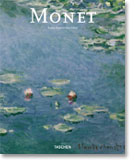클로드 모네(1840-1926)는 가장 전형적이며 가장 개인적인 인상주의 화가이다. 그의 오랜 생애와 독특한 작품은 현실, 특히 전경에서 인간의 눈을 제시하는 그림의 탐구와 센세이션으로 점철된다. 모네의 포플러, 짚더미, 루앙 대성당, 수수련 등은 인상주의 중 가장 사랑 받는 작품이며 현재도 이어지고 있으며 모던 아트에 큰 영향을 주었다.
The author:
Karin Sagner-Duchting studied art history, new German literature, and classical archaeology at Munich University. She received her doctorate in 1983 with a thesis on Claude Monet’s water lily paintings and was academic assistant at the Bayerische Staatsgemaldesammlungen until 1988. Based in Munich, she researches and publishes in the field of 19th-century art.
Karin Sagner-Duchting studied art history, new German literature, and classical archaeology at Munich University. She received her doctorate in 1983 with a thesis on Claude Monet’s water lily paintings and was academic assistant at the Bayerische Staatsgemaldesammlungen until 1988. Based in Munich, she researches and publishes in the field of 19th-century art.
 |













